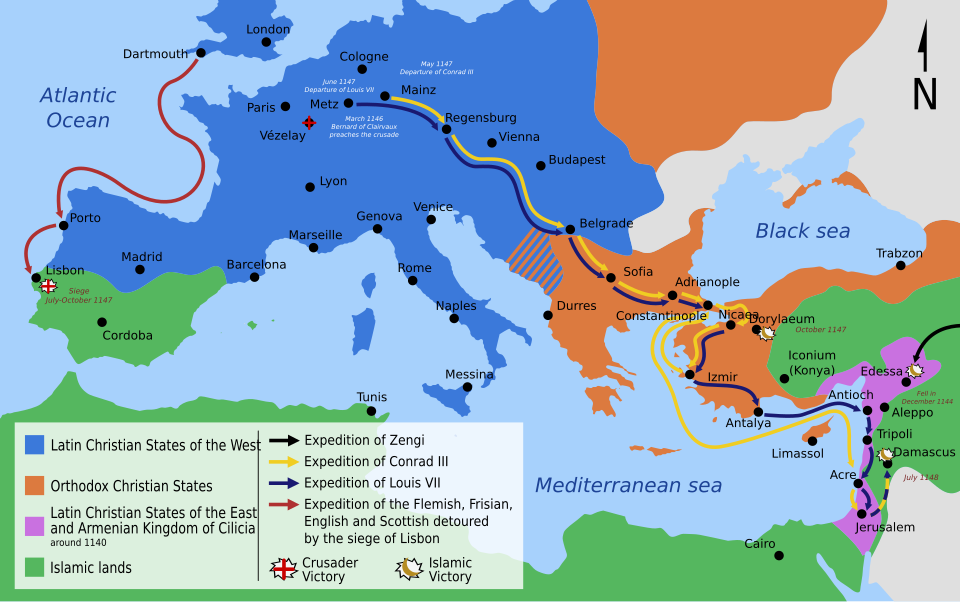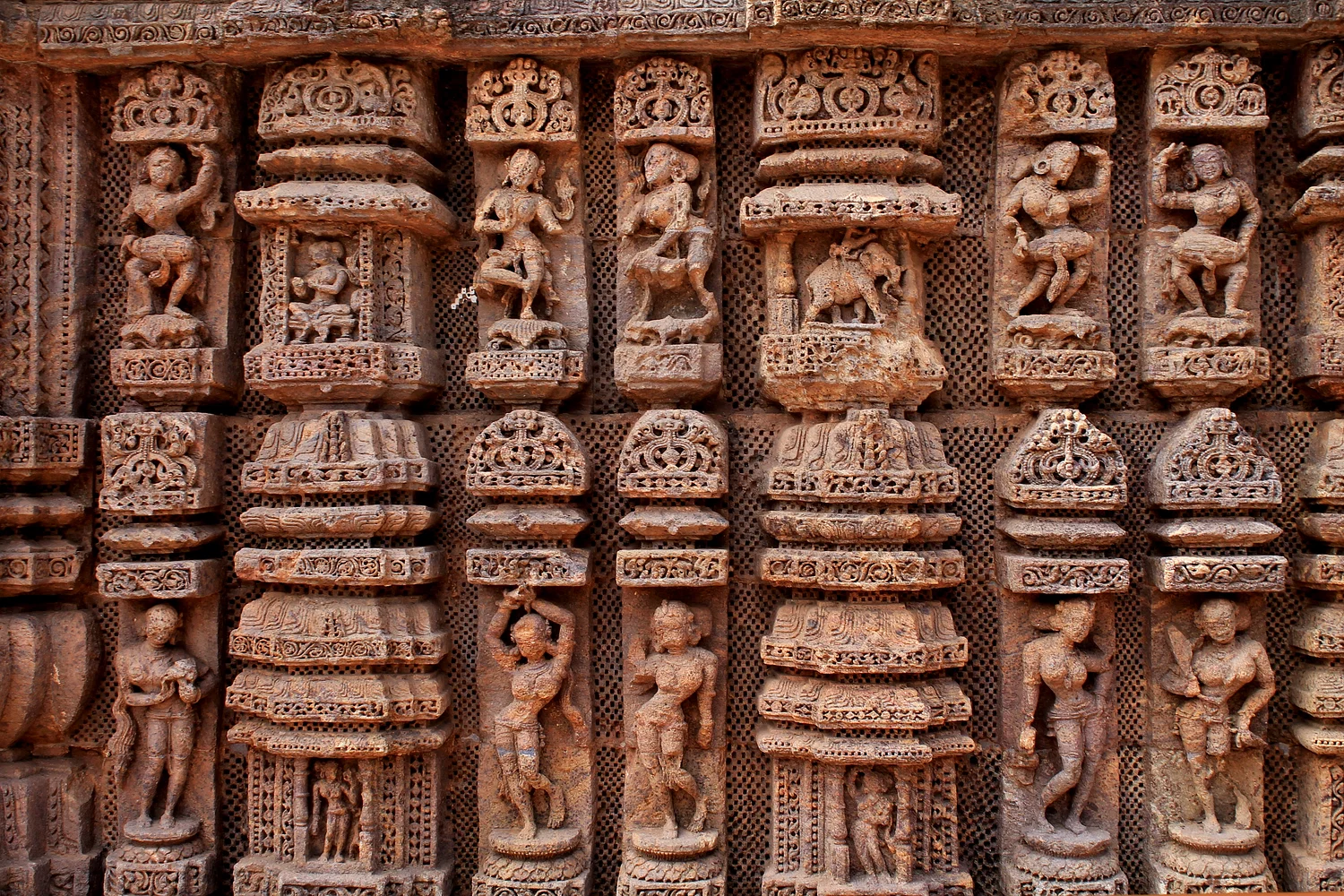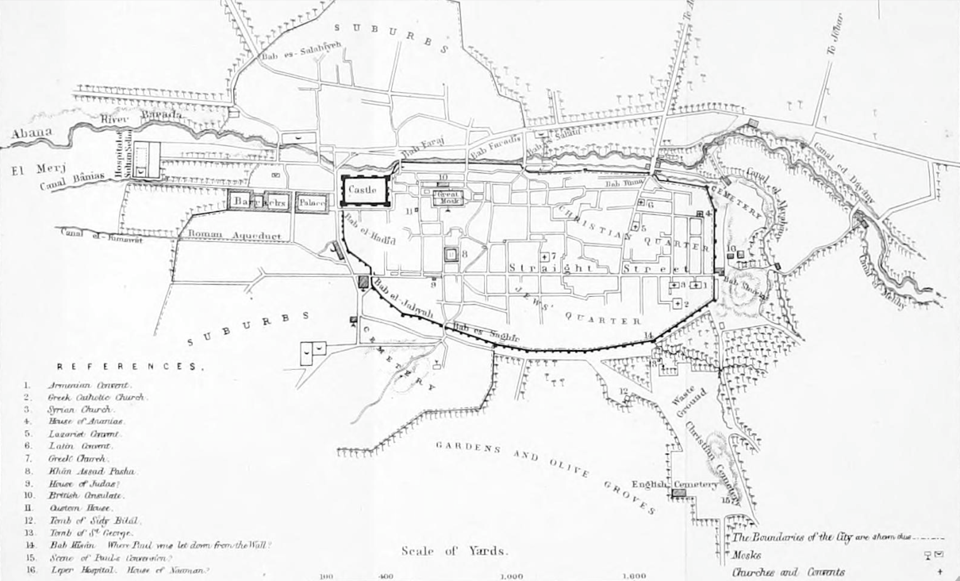OCR Specification focus:
‘Events in Anatolia, Antioch, Acre (1147–1148); siege of Damascus (1148)’
The Second Crusade was shaped by difficult campaigns in Anatolia and a disastrous attempt on Damascus, undermining western confidence and strengthening Islamic resistance.
Campaign in Anatolia, 1147
The German Expedition under Conrad III
The German crusading army, led by Conrad III of Germany, departed in May 1147. Their chosen route took them across the Balkans and into Byzantine lands before pressing through Anatolia. Relations with the Byzantines were strained; Conrad and his forces distrusted Emperor Manuel I Komnenos, suspecting him of collusion with the Seljuk Turks.
Once deep into Anatolia, Conrad’s troops faced:
Logistical shortages, with inadequate supplies in harsh terrain.
Ambushes by Seljuk light cavalry, skilled in mounted archery.
The effects of poor discipline and long marches in the arid summer climate.
At Dorylaeum (October 1147), Conrad’s army was overwhelmed. The Seljuks, exploiting superior knowledge of the terrain and mobile warfare, inflicted a crushing defeat. Only a remnant of the German army survived to retreat to Byzantine territory.
The French Expedition under Louis VII
Louis VII of France led his forces via the same Anatolian route. Initially accompanied by Eleanor of Aquitaine and a large following, the army faced similar problems:
Slow movement and inadequate coordination.
Harassment by Seljuk forces using hit-and-run tactics.
A disastrous crossing of Mount Cadmus in early 1148, where panic in a narrow mountain pass led to chaos and heavy losses.
Though less catastrophic than Conrad’s experience, Louis’s army was gravely weakened. By the time the French survivors reached the coast at Attalia, they had lost cohesion and much of their strength.
Seljuk Turks: A dynasty of Muslim rulers originating from Central Asia, dominant in Anatolia during the 11th–12th centuries, skilled in cavalry-based warfare.
After these ordeals, both German and French contingents limped towards Antioch by sea or land, their numbers and morale badly reduced.
In Anatolia, Conrad III’s Germans were mauled at Dorylaeum (October 1147) and Louis VII’s French suffered badly crossing Mount Cadmus (January 1148), before both contingents pushed on towards Syria.

Map showing the principal Second Crusade routes of Louis VII and Conrad III from Europe into Asia Minor, then on to Antioch and Acre. Labels make the geography of Dorylaeum and Mount Cadmus immediately clear. It is ideal for visualising the campaigning path before the Damascus decision. Source
Events in Antioch and Acre, 1148
Antioch and Prince Raymond of Poitiers
Louis VII reached Antioch in March 1148, where he was welcomed by his wife Eleanor’s uncle, Prince Raymond of Poitiers. Raymond urged the crusaders to assist in attacking Aleppo, the key to securing northern Syria. This strategy, if successful, would have created a buffer zone for Antioch and struck at the heart of Muslim power.
However, Louis rejected the plan, being determined to reach Jerusalem and suspicious of Raymond’s closeness to Eleanor. Tensions between Louis and Eleanor came to the fore, with Eleanor even suggesting remaining in Antioch. Louis forcefully removed her, causing personal discord that undermined cohesion in the crusading leadership.
The Council at Acre
By summer 1148, leaders including Louis VII, Conrad III, and Baldwin III of Jerusalem gathered at Acre. A grand council was held to determine strategy.
Options considered included:
A campaign in northern Syria with Antioch as a base.
An assault on Ascalon, then controlled by the Fatimids of Egypt.
A direct strike on Damascus, a wealthy city and long-standing Muslim rival to Jerusalem.
The decision fell upon Damascus, influenced by its strategic position and its previous hostile actions against the kingdom of Jerusalem. Many also believed its conquest would secure the eastern frontier of Outremer.
Louis VII reached Antioch in March 1148, but at the Council of Acre the leaders agreed to attack Damascus rather than attempt Edessa.

Map of the Near East (1135 CE) highlighting the Crusader States in relation to major neighbours. Use it to orient students to Antioch, Acre, and Damascus before the 1148 siege. Source
The Siege of Damascus, 1148
The Choice of Target
At this stage, Damascus was under the rule of the Burid dynasty, who had at times allied with the Crusader states against other Muslim rivals. Nonetheless, its fertile Ghuta orchards and proximity to Jerusalem made it an attractive prize.
The crusaders believed the city was vulnerable and could be swiftly seized, demonstrating the unity of the Second Crusade.
Outremer: The collective term for the Crusader states established in the Levant (Jerusalem, Antioch, Tripoli, and Edessa).
The Assault
The attack began in July 1148. The crusaders advanced into the rich orchards west of the city, but encountered fierce resistance. The defenders used the dense terrain to their advantage, launching ambushes and disrupting siege preparations.
After three days, food and water shortages, coupled with rising casualties, led the crusaders to reposition to the more arid eastern side of Damascus. This proved disastrous:
The ground lacked natural cover and resources.
The defenders could strengthen fortifications and concentrate resistance.
Morale plummeted among the besieging forces.
Rumours of Nur ad-Din’s army approaching from the north further unsettled the crusaders.
The crusaders attacked from the west through the Ghouta orchards, building works by Bab al-Jabiya before shifting their effort toward the eastern approaches near Bab al-Saghir.

Plan of Damascus showing the Barada River to the north and the walled old city with labelled gates. This clarifies why orchard-lined, wall-bounded approaches constrained crusader movement. Source
Collapse of the Siege
Within only four days, the crusaders abandoned the siege. Their retreat was disorderly and humiliating, leaving Damascus intact and the western armies discredited.
The immediate effects included:
Loss of prestige for both Louis VII and Conrad III.
Anger and resentment from the local population of Outremer, who had expected decisive action.
Damascus turning decisively towards alliance with Nur ad-Din of Aleppo, strengthening Muslim unity against the crusaders.
Consequences of the Campaigns
The campaigns in Anatolia and the failure at Damascus highlighted:
The weaknesses of large western armies operating in hostile terrain.
The disunity between crusader leaders, worsened by personal disputes.
The strengthening of Islamic resistance, as Damascus, Aleppo, and other powers began to align under jihad against the Latin states.
Together, these events ensured that the Second Crusade ended in failure, with long-lasting consequences for Outremer and western confidence in crusading.
FAQ
The Byzantines under Manuel I Komnenos offered limited assistance, but relations with the western leaders were marked by distrust.
Conrad III’s army relied heavily on Byzantine guides and supplies, yet tensions grew due to suspicions of treachery. Western chroniclers often accused Byzantium of secretly favouring the Seljuks, though this is debated by historians.
Ultimately, lukewarm Byzantine support left the crusaders vulnerable in Anatolia, worsening their logistical and military difficulties.
The French army attempted to cross Mount Cadmus in early 1148 through a narrow and steep pass.
A breakdown in discipline led to confusion among baggage trains and infantry.
Panic set in as Seljuk cavalry attacked from higher ground.
Heavy losses were inflicted as many soldiers fell to their deaths or were slaughtered in the chaos.
This incident crippled morale and forced the French to continue in a weakened state.
Eleanor sought to persuade Louis VII to remain at Antioch and support her uncle, Raymond of Poitiers, in an attack on Aleppo.
Her assertive role challenged traditional gender expectations of the time and led to tensions within the crusading leadership.
Louis interpreted Eleanor’s position as disloyalty, and rumours of her closeness to Raymond intensified the dispute. This personal conflict contributed to the French decision to abandon northern campaigns and move towards Jerusalem.
Several reasons influenced the decision:
Damascus had long been a rival of the Kingdom of Jerusalem and posed a strategic threat on its eastern frontier.
It was seen as wealthy and potentially easier to capture quickly.
Aleppo was strongly defended and distant, while Ascalon was under Egyptian control and less immediately threatening.
Attacking Damascus was also intended to showcase unity between western leaders and Outremer rulers, though in reality the choice exposed deep divisions.
Before 1148, Damascus had sometimes allied with crusaders against rival Muslim states.
The siege convinced Damascus’s rulers that the crusaders were an existential threat, leading them to turn decisively towards alliance with Nur ad-Din of Aleppo.
This shift was pivotal: it helped pave the way for greater Muslim unity, strengthening the concept of jihad and consolidating opposition to the crusaders across Syria.
Practice Questions
Question 1 (2 marks)
Name two difficulties faced by the crusading armies while marching through Anatolia in 1147–1148.
Mark scheme:
1 mark for each correct difficulty identified, up to 2 marks.
Acceptable answers include:Ambushes by Seljuk light cavalry.
Shortages of food and water.
Harsh terrain and climate.
Poor discipline and organisation during long marches.
Losses during the crossing of Mount Cadmus.
Question 2 (6 marks)
Explain why the siege of Damascus in 1148 failed.
Mark scheme:
Level 1 (1–2 marks):
Simple statements with little explanation.
Examples: “The crusaders ran out of supplies” or “The defenders resisted strongly.”
Level 2 (3–4 marks):
Some explanation with limited detail.
Examples: “The crusaders faced shortages of food and water, and the defenders attacked them in the orchards, so they moved to a weaker position.”
Level 3 (5–6 marks):
Clear and developed explanation showing understanding of multiple factors.
Answers may include:The crusaders initially attacked from the west through the orchards, where defenders effectively used the terrain.
Shortages of supplies and rising casualties weakened the besieging army.
The shift to the eastern side exposed the crusaders to stronger fortifications and made the position untenable.
Rumours of Nur ad-Din’s approaching army undermined morale.
Disunity among the crusading leaders worsened the situation.
To achieve top marks, candidates must explain at least two well-developed reasons for failure.

